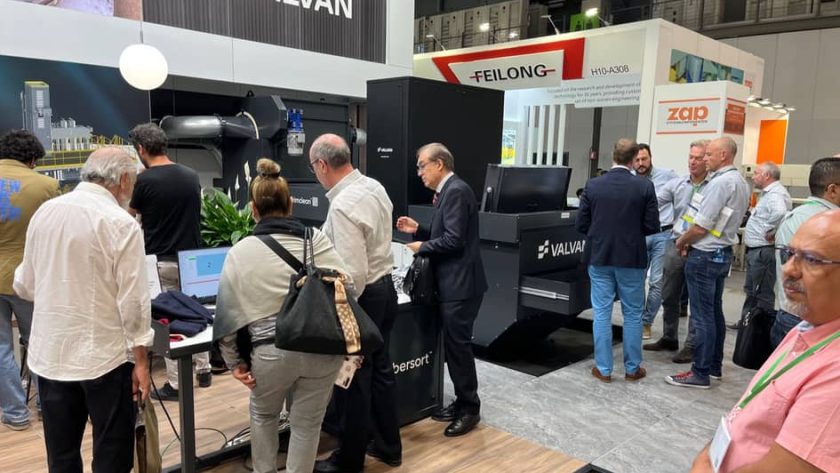Belgian machine builder Valvan has built not one but two machines that facilitate textile recycling. Fibersort and Trimclean can sort textiles automatically. This is the company’s response to impending legislation on textile collection and eco-design.
One garment per second, equivalent to about 1,200 kilograms per hour. That’s how much clothing Valvan’s Fibersort machine processes. Via two robotic arms, the garments disappear into the giant machine at lightning speed. A 3D camera determines the item’s volume and size. Next, an rgb camera (rgb stands for Red, Green and Blue) determines the colour of the garment. Finally, an infrared scanner finds out what kind of fabric the piece is made of.
The latter in particular is Fibersort’s great strength. Valvan has succeeded in building a machine that automatically detects the fibres from which a garment is made. This is necessary to achieve high-quality textile recycling.
Currently, only 0.6 per cent of all discarded textiles are recycled back into clothes, as per the latest figures from Textile Exchange. At the same time, the potential is huge, especially considering that, from 2025, European member states are required to collect half of all textile waste . “In the Netherlands and Belgium we are already reaching those percentages, other member states still have time to take the necessary steps,” Jean-François Gryspeert, sales manager at Valvan, told FashionUnited.
Knowing the composition to be able to recycle
With a machine like Fibersort, textile collectors can use an automatic process to find out whether a T-shirt is made of 100 percent cotton, or rather a blend. The composition of your garment determines whether it can be mechanically, thermomechanically or chemically recycled.
Labels attached to clothes are an unreliable source for this information. Research by Dutch NGO Circle Economy found that four out of ten clothing labels contained incorrect information about the composition of the garment. This was found by conducting a study of 7454 garments in collaboration with the Amsterdam Fashion Institute. For the blends that are more difficult to recycle, as many as 59 per cent were not accurate. The researchers found this out using, yes, Fibersort technology.
Staying ahead of eco-design rules
Textile recycling is becoming an increasingly high priority on the political agenda. The European Parliament approved the ecodesign proposal in early July. That legislation requires companies to put repairable and reusable products on the market. The textile industry is one of the sectors where that need is highest. This is reflected in the Textile Strategy, which was adopted in the Parliament in June.
To apply eco-design to textiles, clothes must be of better quality and recyclable. The composition of textiles is also fodder for debate. There is a chance that clothes will not only have to be recyclable, but will also be required to contain recycled material.
If there is a knowledge of what exactly is in discarded clothes, the industry and consumers will be one step closer. But that is not all for Valvan. Many clothes contain impurities. A zip, a button, a label – which does not even tell the truth: all are ‘polluting’ textile recycling.
Getting imperfect jeans ready for a second life
For this reason, Gryspeert presented Valvan’s latest machine for the first time at the ITMA fair in Milan: the Trimclean. It can detect ‘clean’ patches, and automatically removes contaminated bits of fabric. “First, the garments go through a cutting machine, where they are cut into five-by-five-centimetre patches. Then Trimclean’s camera technology and AI do the rest.”
Back at the headquarters in Menen, Belgium, Gryspeert demonstrates just how that works. A pair of jeans cut into pieces flies through the machine. ‘Clean’ patches of jeans are collected separately. On the other hand, if there is a button or metal stud on the patch – the latter is common on the pockets of jeans in particular – the Trimclean can sort these out.
As such, all textiles that go through the Trimclean are ready for recycling. However, ten to 15 per cent of the textiles are unfortunately lost in the process, because the Trimclean throws away the whole cloth and cannot simply cut the zippers off further.
One could see that as a disadvantage of automation, though Gryspeert views it differently. “It would be far too expensive to take off all those buttons manually. The speed would also have be much higher. At least this way, the trousers don’t go to waste in their entirety, or we don’t export them abroad for processing.”
Investing in machinery
The industry applauds the innovative machine builder. Yet raising enough money to distribute the machines on a large scale remains an issue. For that, recycled fibres are still too expensive compared to virgin fibres. A great deal of fast fashion is made of polyester, a derivative of petroleum, and ridiculously cheap. “So we hope eco-design rules will make it more attractive to use recycled yarn. That way, it will make more sense for companies to invest in machines like ours and we will be able to capitalise sufficiently on our invention,” sales manager Gryspeert concludes.
This article was originally published on FashionUnited.NL. Translation and edit from Dutch into English: Veerle Versteeg.



